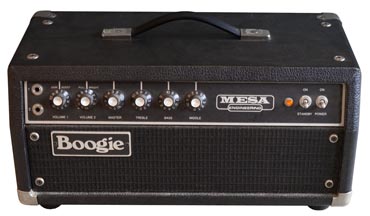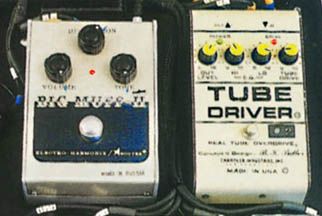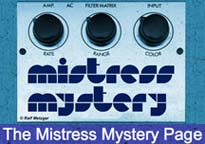NOTE: This website is frequently updated. Last update June 2020.
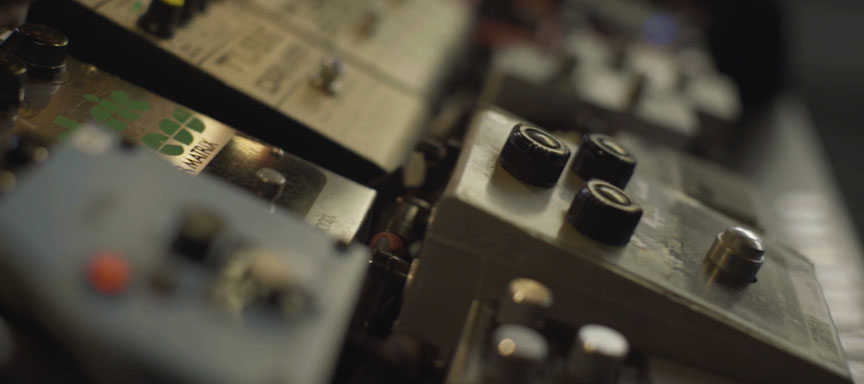
SIGNAL CHAIN ORDER - David Gilmour has used a wide variety of effects on his pedalboards throughout his career - compressors, fuzz/distortion boxes, overdrives, equalizers, modulations like phasers/flanger/chorus, and delays. While there are many choices available for each of those effects to achieve similar tones as David did, it is important to place them in the correct signal chain order to make them process the sound in the same manner to achieve those tones. A compressor is usually placed in the front of the chain to compress the clean signal before any other effects, or to add compression and gain to overdrive and fuzz/distortions that follow it. Overdrives are typically placed after the fuzz/distortions because David likes to blend them together and use the overdrive to EQ the fuzz. The volume pedal is always placed before the delays. Modulations and delays are usually last in line.
Below is a general signal chain order for most eras of Pink Floyd and Gilmour solo work.
GUITAR > COMPRESSOR > FUZZ/DISTORTION > OVERDRIVE > EQUALIZER > VOLUME PEDAL > MODULATION > DELAY > AMPILIFIER
The best examples of why they were placed in this order and how they were used are the song-by-song chains from David's 1994 Pink Floyd Tour , the 1990 Knebworth concert, and 2015/15 Rattle That Lock tour. Experiment and find what works best for you and your rig.
COMPRESSOR PLACEMENT - When David first started using a compressor on his pedalboard in the late 1970s it was placed in the middle of the signal chain. I believe at that time he was only using it to compress his clean tone, so it really could have gone anywhere in the chain. In the 1980s he began combining a compressor with an overdrive or fuzz, so the comp was moved to the beginning of the signal chain. His compressors have been first in line ever since.
BOOST/OVERDRIVE BEFORE OR AFTER THE FUZZ / DISTORTION? - David often boosted/blended an overdrive with his Big Muff fuzz pedals or distortion boxes. His various overdrives included the Colorsound Power Boost, Mesa Boogie Mark I (used as an overdrive in the signal chain), and the Butler Tube Driver. The overdrive can be placed before or after the fuzz, and Gilmour has done it both ways throughout his career. In the early to mid 1970s he placed the overdrive before the fuzz, and by the late 1970s he placed fuzzes both before and after the overdrives. In the 1980s he placed the overdrive after his fuzz pedals. In the 1990s he mostly placed the overdrive before the fuzz, but in some instances placed it after. In the 2000s he placed the overdrives after the fuzzes.
FUZZ FACE PLACEMENT- Because of the nature of the Fuzz Face circuit design and the low impedance input that loads the guitar pickups, Fuzz Face type circuits are usually placed first in line after the guitar in a signal chain to sound correct. The transistors need to "see" the guitar pickup's impedance directly because they are integral to and function as a part of the guitar circuit. Placing other pedals, especially a pedal with a buffer, before a Fuzz Face can severely alter the tone. David used the FF first in his signal chain, but in his live rigs from 1972-74, David placed his Colorsound Power Boost first in line, with the Fuzz Face immediately following it in the signal chain.
There are some fuzz pedals, like the Skreddy Lunar Module, that can generate a similar sound as the Fuzz Face using circuit designs that allow them to be placed anywhere in the signal chain.

POWER BOOST PLACEMENT- The Colorsound Power Boost was an overdrive that David used throughout the 1970s. From the 1972-74 period he used the PB first in line in the signal chain for his live rigs. It was set for a light overdrive setting and was most likely an always-on pedal. It only added a very slight gain boost to his clean amp tone, but where it made a huge difference is how it affected the Fuzz Face that followed it for David's high gain lead tones in this period. I think that combo, in that order, was the core of that sound, so I recommend placing the PB first in line to replicate those tones.
For David's 1975-77 period, he used the PB more as an typical overdrive, with higher gain settings. It was moved farther down the signal chain, after the Fuzz Face and modulation effects.
EQUALIZER PLACEMENT - In general David usually places equalizers afer all the compressors, fuzz and overdrive pedals. In some instances he has placed an equalizer after each individual effect pedal in a loop.
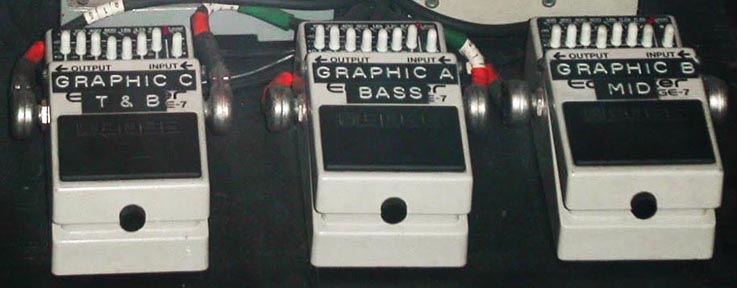
MODULATION BEFORE OR AFTER THE DELAY? - Modulations are effects like phasers, univibes, flangers, and chorus. They can go before or after the delay, and Gilmour has done it both ways throughout his career. I cannot really tell much difference either way, but I prefer delays to be last in line before the amps.
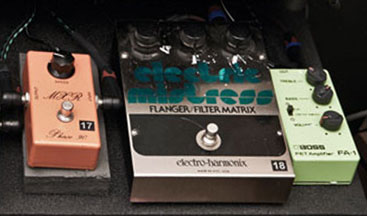
VOLUME PEDAL PLACEMENT - It is important that the volume pedal be placed before the delay in the signal chain. This allows you control over the level of signal being fed into the delay without affecting the delay repeats. The primary purpose of this is to cut off the volume when an effect is not in use during parts of a song, or to kill the sound entirely at the end of a song, but allow the delay trails to continue rather than be abruptly cut off. Another purpose that David used a volume pedal for was to create volume swells. For example, David sometimes picks a note or chord with the volume off, then fades in the sound with the volume pedal so you hear the sound "swell" but do not hear the string actually being picked. Another example of volume pedal use is the intro and outro to the song Sorrow. David usually has the sound on the edge of feedback and keeps the volume pedal backed off slightly when playing the phrases, then pushes the volume to full when he wants the feedback. In between the phrases he keeps the volume off so you don't hear the high gian hiss of the Big Muff and booster.
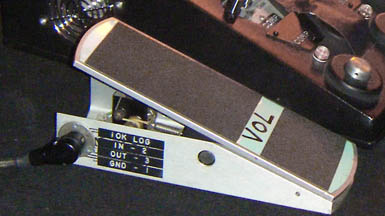
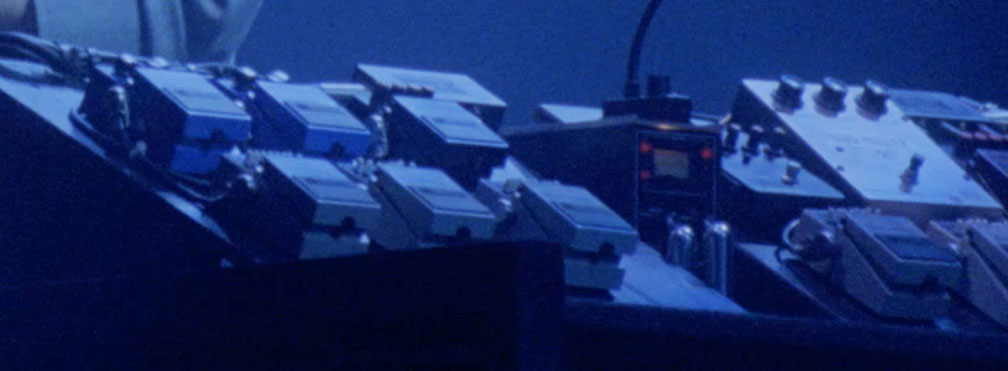
GILMOUR SIGNAL CHAIN ORDERS THROUGHOUT THE YEARS - Below is a simple run down of how Gilmour's signal chain has evolved over the years.
Early 1970s period including Meddle, Pink Floyd: Live at Pompeii, Obscured by Clouds, and Dark Side of the Moon.
GUITAR > OVERDRIVE > FUZZ > WAH > VOLUME PEDAL > MODULATION > DELAY > AMPLIFIER
_____________________________________________________
Late 1970s including Wish You Were Here performances and Animals
GUITAR > FUZZES > MODULATIONS > OVERDRIVE > WAH > COMPRESSOR > FUZZ > VOLUME PEDAL > DELAYS > AMPLIFIER
_____________________________________________________
1980-1983 period including The Wall and The Final Cut
GUITAR > FUZZES > MODULATIONS > OVERDRIVE > WAH > COMPRESSOR > VOLUME PEDAL > DELAYS > MODULATION > AMPLIFIER
_____________________________________________________
1990-1992 period
GUITAR > COMPRESSORS > FUZZ > EQUALIZER > VOLUME PEDAL > DELAY > MODULATION > AMPLIFIER
_____________________________________________________
1993-1994 period, including The Division Bell tour and Pulse
GUITAR > COMPRESSORS > WHAMMY > OVERDRIVE > FUZZES > OVERDRIVE > MODULATIONS > EQUALIZERS > VOLUME PEDAL > DELAY > MODULATIONS > AMPLIFIER
_____________________________________________________
2000-2019 period, including the Meltdown concerts, the Live 8 Pink Floyd reunion, the On an Island tour, The Endless River/Rattle That Lock sessions, and guest appearances.
GUITAR > COMPRESSOR > WHAMMY > FUZZ > OVERDRIVES > EQUALIZER > VOLUME PEDAL > DELAY > MODULATIONS > AMPLIFIER
_____________________________________________________
2015-16 Rattle That Lock tour and David Gilmour Live at Pompeii
GUITAR > COMPRESSORs > WHAMMY > FUZZes > OVERDRIVES > MODULATION > EQUALIZERS > VOLUME PEDAL > DELAYS > AMPLIFIER
Kit’s Secret Guitar, Gear, and Music Page
Guitar stuff, gear stuff, soundclips, videos, Gilmour/Pink Floyd stuff, photos and other goodies.
Copyright Kit Rae.
VISIT MY SWORDS, KNIVES and FANTASY ART WEBSITE www.kitrae.net


